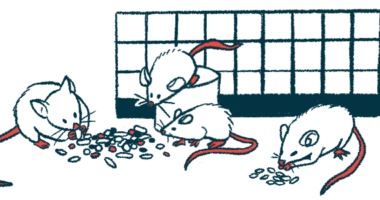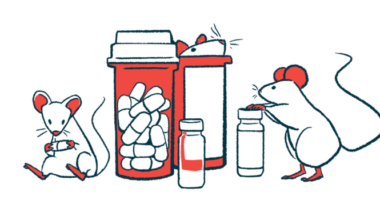Stem cell-based gene therapy seen to correct protein defects in mice
May be potential 'new treatment option' for Pompe, researchers say

A stem-cell based gene therapy that’s modified for better entry into muscle cells was seen to normalize protein levels in the skeletal muscle tissue of a mouse model of Pompe disease, according to a new report.
The Pompe mice exhibited altered levels of hundreds of proteins — including ones involved in muscle contractions, inflammation, and cellular energy production — relative to healthy mice. The modified gene therapy corrected nearly all of them.
These findings add to those of a previous study showing that the gene therapy could reduce glycogen buildup and ease motor impairments in the Pompe mouse model.
Together, the researchers noted, these results position it as “a new treatment option for Pompe disease.”
The study, “Lentiviral gene therapy with IGF2-tagged GAA normalizes the skeletal muscle proteome in murine Pompe disease,” was published in the Journal of Proteomics.
New gene therapy approach would be alternative to ERT in Pompe
In Pompe disease, mutations in the GAA gene cause a lack of functional acid alpha-glucosidase, or GAA, an enzyme needed to break down a sugar molecule called glycogen. As such, glycogen accumulates to toxic levels inside lysosomes, the cell compartments responsible for clearing waste.
A mainstay treatment strategy for the genetic disease is enzyme replacement therapy (ERT), but it involves lifelong infusions of a lab-made version of GAA.
Efforts now are underway to develop gene therapies for Pompe that could involve a single delivery of a working version of GAA to cells, enabling the body to continuously produce its own enzyme.
For delivery into the stem cells, the gene is packaged into a viral carrier called a lentivirus, which is modified to not cause disease.
One way of doing this involves hematopoietic stem cells, or HSCs, which give rise to all mature blood cells in the body. The strategy, called an HSC-mediated lentiviral approach, involves collecting these stem cells from a patient’s bone marrow and treating them in the lab with a healthy version of GAA. For delivery into the stem cells, the gene is packaged into a viral carrier called a lentivirus, which is modified to not cause disease.
The stem cells are then returned to the patient, where they can populate the blood with cells capable of making their own GAA enzyme.
In a previous study, the research team developed a next-generation version of HSC-mediated gene therapy in which the GAA gene was fused to the IGF2 or insulin-like growth factor 2 gene. This leads to the production of a GAA enzyme fused to the IGF2 protein, which helps improve cellular uptake into muscle cells.
This version of the gene therapy prevented glycogen buildup to a greater degree than a gene therapy without IGF2 tagging in a mouse model of Pompe.
Gene therapy found to correct all but 21 of nearly 500 proteins
Now, the researchers further investigated how the gene therapy affected protein levels in the muscle tissue of the mouse model. Their goal was to get sense of how the the treatment was impacting cellular function.
First, the scientists investigated how the protein composition in the muscle tissue of the Pompe mouse model differed from that of healthy mice.
A total of 480 proteins were found to be expressed at different levels in the Pompe model relative to healthy animals. That indicated a generally disrupted proteome, which is the complete set of proteins produced by an organism.
These protein changes corresponded with a range of cellular pathways, some of which had been previously identified. Among the altered pathways were those related to glycogen metabolism, muscle contractions, inflammation, and lysosome function, among others.
Next, the Pompe mice were either given the IGF-fused gene therapy, dubbed LV-GAA-IGF, or a similar gene therapy without IGF — this one called LV-GAA. Proteomic analysis of the skeletal muscle tissues was conducted six months later.
While LV-GAA resulted in a partial correction of the proteomic changes observed in the Pompe mouse model, LV-GAA-IGF “was able to induce a near-complete correction of protein expression” or activity, the researchers wrote.
This study highlights the efficacy and safety of lentiviral gene therapy using [LV-GAA-IGF], and supports the clinical development of this therapy as an alternative treatment for Pompe disease.
Across the nearly 500 altered proteins observed in the mouse model, 21 remained significantly altered after the LV-GAA-IGF gene therapy, whereas 239 remained altered with LV-GAA. With both therapies, and as expected, GAA was the most altered protein.
According to the researchers, a possible safety risk with an IGF fused therapy is low blood sugar, known as hypoglycemia, because it binds to the same receptors as insulin, the molecule that helps control blood sugar levels. Indeed, an investigational IGF-fused ERT was associated with hypoglycemia in a clinical trial.
In the previous mouse study, blood sugar was not altered after LV-GAA-IGF therapy. In this study, there were no proteins specifically altered with LV-GAA-IGF, which otherwise would lead the scientists to suspect such a safety effect.
“Together, this study highlights the efficacy and safety of lentiviral gene therapy using [LV-GAA-IGF], and supports the clinical development of this therapy as an alternative treatment for Pompe disease,” the researchers concluded.








